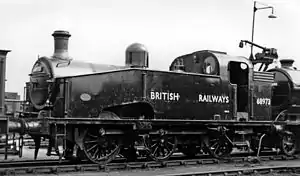GNR Class J23
The Great Northern Railway Class J23 was a class of 0-6-0T steam locomotive. They had long side tanks that came to the front of the smokebox, which sloped forwards to improve visibility and had a recess cut in to aid maintenance. Forty were built by the Great Northern Railway (GNR) between 1913 and 1922, with a further 62 being added by the London and North Eastern Railway (LNER) between 1924 and 1939. They were given the nickname "Submarines" due to their long tanks.[1]
| GNR Class J23 LNER Classes J50 & J51 | |||||||||||||||||||||||
|---|---|---|---|---|---|---|---|---|---|---|---|---|---|---|---|---|---|---|---|---|---|---|---|
 J50/3 No. 68973 0-6-0T at Doncaster Locomotive Depot, fresh from repair at Doncaster Works | |||||||||||||||||||||||
| |||||||||||||||||||||||
| |||||||||||||||||||||||
| |||||||||||||||||||||||
| |||||||||||||||||||||||
History
For shunting and local goods work, the Great Northern Railway (GNR) had traditionally used saddle-tank engines of the 0-6-0 wheel arrangement; the last of these, of GNR Class J13, having been built in 1909 to the designs of H.A. Ivatt, the GNR Locomotive Superintendent.[2][3]
Nigel Gresley succeeded Ivatt in 1911,[4] and soon identified a need for engines to work the short-haul coal traffic in the West Riding of Yorkshire; the nature of which required that the locomotives also be suitable for shunting. He designed a new class of 0-6-0 tank engine, using side tanks instead of saddle tanks.[5] Gresley had recently begun the rebuilding of the GNR Class L1 0-8-2T locomotives with larger boilers, 4 feet 8 inches (1.42 m) in diameter,[6] which left a number of 4-foot-2-inch (1.27 m) diameter boilers spare. Thirty of these were used in the construction of the new goods tank engines between 1913 and 1919;[5] when ten more were built in 1922, these again used secondhand boilers, but 4 feet 5 inches (1.35 m) in diameter.[7] On the GNR, both varieties were classified J23, but the LNER divided them into J51 with smaller boilers, and J50 with larger boilers.[5] The LNER continued the construction of Class J50, building a further 62 up to 1939,[8] only the first ten of which were given secondhand boilers.[9] Class J51 were rebuilt to class J50 between 1929 and 1935.[5]

Each of the two main classes exhibited variations: locomotive brakes could be operated by vacuum or steam pressure; the driving position could be on the right- or the left-hand side of the cab; and there were three sizes of coal bunker. These variations were recognised by class subdivisions:[8]
- J51/1 10 built 1913–14, 4 ft 2 in boiler, vacuum brake, right-hand drive, short bunker
- J51/2 20 built 1914–19, as J51/1 but long bunker
- J50/1 10 rebuilt 1929–35 from J51/1 with 4 ft 5 in boiler
- J50/2 20 built 1922–24, as J51/2 but 4 ft 5 in boiler, plus 20 rebuilt 1929–34 from J51/1 with 4 ft 5 in boiler
- J50/3 38 built 1926–30, 4 ft 5 in boiler, steam brake, left-hand drive, long bunker
- J50/4 14 built 1938–39, 4 ft 5 in boiler, vacuum brake, left-hand drive, long bunker with hopper
All were built at Doncaster, except the last fourteen which were built at Gorton.[10] Further orders were placed in 1939 and 1941 totalling 25 more locomotives, but these were cancelled in 1942 after a number of components had been manufactured.[11] Withdrawals began in 1958 with the arrival of diesel shunters and ended in 1963 for the normal stock. 7 of them survived as departmental stock until 1965. The class became extinct in September 1965 when Departmental No. 14 (ex-68961) was withdrawn and scrapped. None of them survived into preservation.[12]
Numbering
On the GNR, the numbers were 157–164, 166–176, 178, 211–230; these were increased by 3000 by the LNER.[13] The first ten engines built by the LNER were numbered 3231–40, following on from the GNR engines;[14] but those built from 1926 were given scattered numbers between 583 and 636, between 1037 and 1086, and 2789–94.[15]
In 1943, new numbers were allotted in a continuous block from 8890 to 8991; these numbers were applied between January and December 1946,[16] but before this could be done, the oldest ten, nos. 3157–64/6/7 were temporarily renumbered 3180–9 in May and June 1945. They duly received their permanent numbers 8890–9 between June and December 1946.[17] Under British Railways, the 1946 numbers were increased by 60000.[18]
Notes
- "The Gresley J50 & J51 (GNR J23) 0-6-0T Locomotives". LNER. Retrieved 31 January 2019.
- Groves 1987, pp. 260–2.
- Allen et al. 1970, pp. 25–26.
- Groves 1992, p. 3.
- Groves 1992, p. 65.
- Groves 1990, pp. 75–76.
- Groves 1992, p. 70.
- Allen et al. 1970, p. 7.
- Groves 1992, pp. 71,72.
- Allen et al. 1970, pp. 8,11,12.
- Allen et al. 1970, p. 13.
- "The Gresley J50 & J51 (GNR J23) 0-6-0T Locomotives". LNER Encyclopedia. Retrieved 23 October 2020.
- Allen et al. 1970, pp. 7,8,11.
- Allen et al. 1970, p. 11.
- Allen et al. 1970, p. 12.
- Allen et al. 1970, p. 8.
- Allen et al. 1970, p. 19.
- Allen et al. 1970, p. 16.
References
- Allen, D. W.; Boddy, M. G.; Brown, W. A.; Fry, E. V.; Hennigan, W.; Manners, F.; Neve, E.; Proud, P.; Roundthwaite, T. E.; Tee, D. F.; Yeadon, W. B. (November 1970). Fry, E. V. (ed.). Locomotives of the L.N.E.R., part 8A: Tank Engines - Classes J50 to J70. Kenilworth: RCTS. ISBN 0-901115-05-3.
- Groves, Norman (1987). Great Northern Locomotive History: Volume 2 1867-95 The Stirling Era. RCTS. ISBN 0-901115-62-2.
- Groves, Norman (1990). Great Northern Locomotive History: Volume 3a 1896-1911 The Ivatt Era. Lincoln: RCTS. ISBN 0-901115-69-X.
- Groves, Norman (1992). Great Northern Locomotive History: Volume 3b 1911-1922 The Gresley Era. Lincoln: RCTS. ISBN 0-901115-70-3.
External links
| Wikimedia Commons has media related to GNR Class J23 / LNER Class J50. |